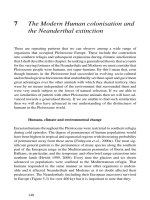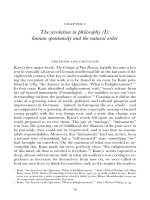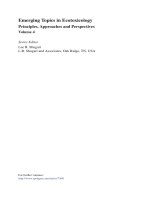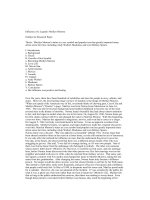Human exposure through the environment 2010
Bạn đang xem bản rút gọn của tài liệu. Xem và tải ngay bản đầy đủ của tài liệu tại đây (4.96 MB, 20 trang )
1
Human environmental
exposure
Martin van den Berg
Institute for Risk Assessment Sciences
Utrecht University
Primary routes of human
exposure to chemicals
! In the ambient environment:
Dust and vapor inhalation
Dermal contact with contaminated soil or dust
Ingestion of contaminated food, water, dust or soil
! In the workplace environment:
Predominant route is inhalation or dermal contact
Minor dust ingestion and hand to mouth contact
2
The environmental pathways to human
exposure (Paustenbach 2002)
Concepts of exposure and dose
! Actual contact of the organism
! Actual entry of the chemical (crossing a
boundary)
! Degree of absorption leads to (bio)
availibility and amount of chemical that
is toxicological relevant
! This is internal or target tissue dose
influenced by body distribution factors
3
Crossing the boundary from the
“outside to the inside”
! Intake:
Physical movement
from the chemical by
inhalation, eating or
drinking
Chemical contained
in medium such as
food, soil, dust or
water
! Uptake:
Physical uptake and
transport across a
boundary in the body
(e.g. skin or GI-tract)
that is a cell layer
Transport medium is
usually not absorped
with same rate as
the chemical
Bioavailability
Lipophilicity
Concept of applied, potential and
internal dose
! Applied dose:
Amount of chemical
available at the
absorption barrier
(e.g. lung, GI
tract,skin)
! Potential and internal
dose:
This is the difference
with applied dose
This is the
toxicological relevant
parameter after body
distribution has been
taken into account
Biological relevant dose (BED) is
ultimate goal for exposure assessment !
Xeno-estrogens
and kinetics
4
Integrated exposure
Area under the curve (AUC)
! Identification of:
Duration and periodicity of exposure
Amount of peak exposure
Shape of the area under the time concentration curve
(Ref. Paustenbach et al 2002)
Determining (Lifetime) Average Daily Dose
(LADD and ADD)
5
Time weighted average dose
(Lifetime) average daily dose (L)ADD
6
Quantifying Exposure
! Direct measurement
Integrating exposure concentration and
time of contact
! Exposure scenario
Hypothetical exposure, but realistic
! Biomonitoring Data
Using internal indicators: biomarkers,
excretion levels, body burden
Gasses
Occup exposure
Worst case
Types of biomonitoring sampling
! Method
! Breath
! Blood
! Adipose
! Nails, Hair
! Urine
! Blood, urine, hair
! Example
! Volatile organics, alcohol;
! Lead, pesticides, heavy metals
! Chlorinated pesticides, dioxins
! Heavy metals
! Tetra/trichloro-ethylene
! Drugs, pharmaceuticals
7
Obtaining Uptake and Intake data
! Large number of variables e.g.:
Drinkingwater consumption
Consumption fruit, vegetables, beef, dairy etc
Consumption recreation caught fish
Incidental soil ingestion rate
Effective surface area of the body
Hormones
Lipophilic
compounds
Pesticides
Lipophilic
compounds
Some standard
assumptions for
exposure (EPA
1996)
8
Direct and indirect exposure pathways
An example Municipal Incinerators
(D. Paustenbach et al, 2002)
Dioxins and
heavy metals
Bioavailibility
Breastmilk
Dioxins in foodstuff in the Netherlands and
effect of lifestyle (Liem and Theelen, 1997)
Dutch Turks
General Dutch population
1 % or more of Turks exceeds 10 times the WHO TDI
9
Percentage of Dutch population exceeding the TDI of
dioxin in The NL
(Liem and Theelen 1997)
> 80% exceeds WHO TDI
1-1.5% exceeds 10x WHO TDI
More than 150.000 people
Infant
Influence of animal (dairy) products on the exceedence
in the Dutch population (Liem and Theelen,1997)
Aslight increase e.g. from 4 to 5 pg TEQs/
g fat means a few % of the Dutch
population exceeds TDI and involves
easily more than 100.000 people
10
What are background levels?
! “Pristine” levels: Not similar to background levels as areas
without anthropogenic influence do not exist anymore on this
planet
! “Normal” levels: Average levels that are found e.g. in rural areas
without significant influence of industry, traffic or geochemical
anomalies
! “Historically polluted regions”: E.g. densely populated regions
that have been polluted by e.g. industry, mining and traffic
! Geochemical variation: Background “natural” levels of toxic
elements (e.g. heavy metals) may vary with regions due to
geochemical variations (e.g. arsenic in the US)
Dermal transport of chemicals
! Major determinants: solubility (Kow) and
matrix/medium (bioavailability)
! Transport inverse function of molecular
weight and volume
Consequence: hydrophobic agents with low MW
permeate better than hydrophilic agents with high
MW. For small molecules hydrophobicity major
factor dermal penetration
! Lipophilic compounds tend to
accumulate in stratum corneum
! Decreasing Permeability: foot/sole >
palm > scrotum > forehead > abdomen
11
Estimation of uptake via the skin
(Fick’s law of diffusion at steady state)
! Partition parameter Kp is key parameter and
be approached with Kow
Key factors that influence dermal uptake of
xenobiotics from the environment
! Bioavailability: large impact on uptake and depends on the
organic content soil
! Skin surface area: use rule of “nines”. 9 percent for head and
neck and each upper limb. 18 percent for each lower limb. Front
of back of the trunk also each 18 percent. US EPA estimates
exposed area of 2900, 3400 and 2940 cm2 for children from 0-2
and 2-6 years, and adults
! Actual soil loading on the skin: 0.5-6 mg/cm2 and 0.2 to 2.8 mg/
cm2 for adults and children
12
Calculation of dermal
uptake of chemical in
gaseous or aqueous
media
(Paustenbach 2002)
Human cutaneous permeability
coefficients (cm/h)
in aqueous medium
(From Paustenbach 2002)
13
Representative
surface area’s of the
male human body
(Paustenbach 2002)
US-EPA suggested method for
percutanous absorption from soil:
An example: Skin uptake of a chemical from water
(from Paustenbach 2002)
14
! Soil ingestion
! Indoor and outdoor exposure
! Varies strongly with age,
most significant between 2
and 7 years
! Uptakes varies between
several mg/d for adults up to
many 100’s mg/d for children
(Pica)
! Bioavailibility is a significant
parameter for eventual risk
! (Table from Paustenbach
2002)
! Estimating intake via food
! Limit expressed as ADI or
TDI (gram unit/kg bw – day)
! Lifestyle is major uncertainty
in determining actual uptake
for the population
! Lipophilic contaminants
mostly via dairy, meat and
fish
! Uptake pesticides also
through vegetables and fruit
! (Table from Paustenbach
2002)
15
! Breast milk – a special situation
! TDI or ADI not applicable (no life time exposure)
! Accumulation of lipophilic compounds (e.g. PCBs, dioxins) and drugs
! Disadvantages and advantages
! (Table from Paustenbach 2002)
! Intake via inhalation – relative small numbers of uncertainty
! Most significant variables: inhalation rate, airborne chemical
concentration, bioavailibility and particle size
! Major differentation between gases and particles with adsorped
contaminants (bioavailibility)
! (Table from Paustenbach 2002)
16
Particle size inhalation
! Major disposition areas:
Nasal or Oral region
Trachea region
Bronchial region
Alveolar region
Disposition of particles in respiratory tract
! Major deposition ways:
Interception, impaction, sedimentation, diffusion
! Particle clearance:
1) GI tract, 2) lymphatics and lymph nodes,
3)pulmonary vasculature -> venous circulation
! Nasal clearance:
Swallowing, wiping, blowing
! Trachealbronchial clearance:
Coughing, upward movement, swallowed
! Pulmonary clearance:
Upward movement mucociliary escalator
Phagocytized by macrophages cleared by
mucociliary escalator
Phagocytized by alveolar macrophages
removed by lymphatic drainage
Dissolvement from surfaces particles and
removed by bloodstream or lymphatics
Direct penetration small particles epithelial
membranes -> blood or lymphatics
17
Institute for Risk Assessment Sciences
Prof. dr. Martin van den Berg
O
S
S
T
I
I
Æ
L
L
V
S
T
R
A
N
O
S
L
V
I
I
T
University of Utrecht
Degree of response
Increasing exposition
Safety standard
air/product
No effect
animal
Lowest
effect
Safety margin 100
1/10 inter humans * 1/10 animals -> humans
Harbor personel
(not protected)
Wharehouse personel
(not protected)
Consumers
?
Methylbromide/Dichloorethaan in containers:
Interpretation measurements ZfAM (Germany/Netherlands)
Increasing exposition
Lowest
effect
Safety margin
?
Methylbromide: Exposure and Effects
human
Acute – high:
Death, coma, seizure,
lung, hart and vascular
damage, strong
neurological and
behaviorial effects,
kidney/stomach effects
Acute – low:
Mild neurological and
behavioral effects,
lung and stomach
damage
Chronic– low:
Irritation lungs (inhalation)
and GI tract(oral),
mild neurological and
behavioral effects
Chronic-high:
Lung, heart and vascular
damage, strong neurological
and behavioral effects
kidney/stomach effects
Consumer/employer
Employer
Most important for
unprotected consumers
O
S
S
T
I
I
Æ
L
L
V
S
T
R
A
N
O
S
L
V
I
I
T
University of Utrecht
Institute for Risk Assessment Sciences
Prof. dr. Martin van den Berg
Safety standard
air/product
No effect
animal
Degree of response
18
Veiligheids marge
?
Dichloorethaan: Exposure and Effects
Consumer/employer
Employer
Acute - high:
Death, depression
central nervous
system, asphyxiation
heart, liver, kidney and
brain damage,
general sedation
Acute – low:
Mild effects
Central nervous system
Respiration, cardiac rhythm
mild sedative effect
Chronic - low:
Effect on heart and
Respiration and nervous
system, carcinogenic?
Chronic-high:
Depression central
nervous system and
respiration,heart,
liver,kidney and
brain damage,
carcinogenic ?
Most important for
sensitive unprotected
consumers
O
S
S
T
I
I
Æ
L
L
V
S
T
R
A
N
O
S
L
V
I
I
T
University of Utrecht
Institute for Risk Assessment Sciences
Prof. dr. Martin van den Berg
Increasing exposition
Lowest
effect
human
Safety standard
air/product
No effect
animal
Degree of response
Contamination consumer products from containers
result from different sources!
Cheap and old fashioned
Production process with
benzene en toluene
Outside Europe en N-America
Fumigation with
methylbromide
and dichloroethane
Exceeds safety standard
consumer
in a chemical cocktail
+
=
O
S
S
T
I
I
Æ
L
L
V
S
T
R
A
N
O
S
L
V
I
I
T
University of Utrecht
Institute for Risk Assessment Sciences
Prof. dr. Martin van den Berg
19
Protection consumer from public health point of view
(precautionary principle?)
• No action is no option due to measurable risks for both employers
and consumers (e.g. methylbromide in cacoabutter, benzene in
matrasses….)
• Most logical legislation:
– No use methylbromide, dichloroethaan with food products (FAO) and
‘close contact’ consumer products with synthetic foam
• Continuation fumigation food products and “close contact” consumer
producten use a sticker for consumer warning about possible risks.
Bijv:
• The use of fumigation of pharmaceutical never allowed!
– Risk of damaging the quality of the reactive part of
the pharmaceutical by the methylbromide
This product is fumigated and
possibly damages your health
and the environment
O
S
S
T
I
I
Æ
L
L
V
S
T
R
A
N
O
S
L
V
I
I
T
University of Utrecht
Institute for Risk Assessment Sciences
Prof. dr. Martin van den Berg
Some significant issues in exposure assessment
! Bioavailability – relevant for food, soil and airborne particles
! Chemical fate – (bio)degradation e.g. by sunlight, oxidation,
hydroxylation and microorganisms
! Biomarkers and molecular epidemiology – e.g. Proteins, RNA,
DNA and their adducts
! What is the toxicological relevance?
! With increasing molecular and biochemical techniques (e.g.
genomics and proteomics) more identification of biomarkers, but
how relevant are these effects with respect to the real observed
adverse dose response relationships
20
A definite must for the risk assessment!
Human and Ecological Risk Assessment
Theory and Practice
By
Dennis J. Paustenbach
(Wiley-Interscience, New York, 2002)









